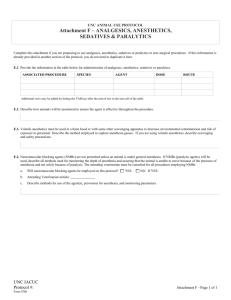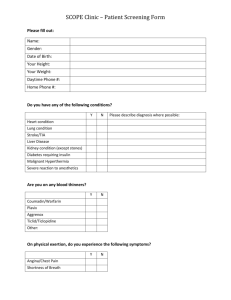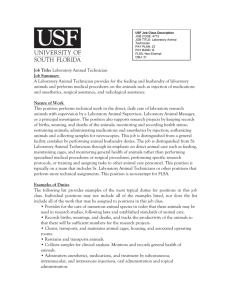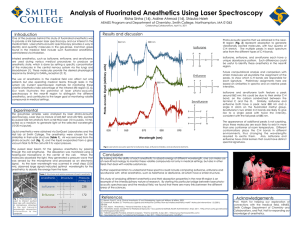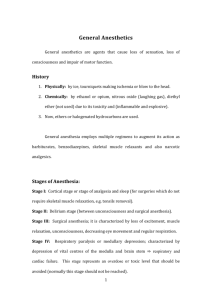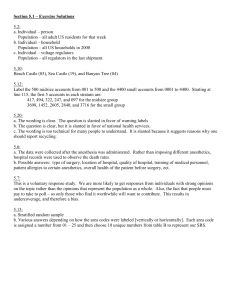General Anesthetics
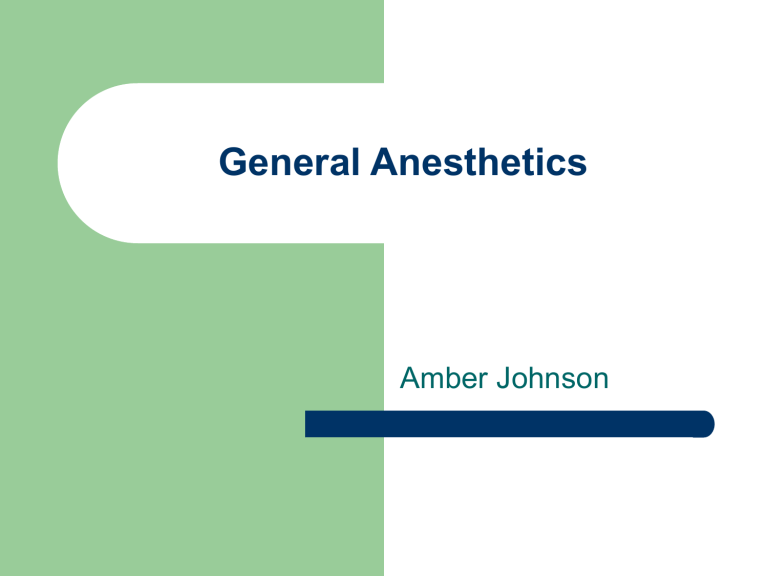
General Anesthetics
Amber Johnson
What are General Anesthetics?
A drug that brings about a reversible loss of consciousness.
These drugs are generally administered by an anesthesiologist in order to induce or maintain general anesthesia to facilitate surgery.
Background
General anesthesia was absent until the mid1800’s
William Morton administered ether to a patient having a neck tumor removed at the
Massachusetts General Hospital,
Boston, in October 1846.
The discovery of the diethyl ether as general anesthesia was the result of a search for means of eliminating a patient’s pain perception and responses to painful stimuli.
(CH
3
CH
2
)
2
O
Anesthetics divide into 2 classes:
Inhalation
Anesthetics
–
–
Gasses or Vapors
Usually Halogenated
Intravenous
Anesthetics
–
–
Injections
Anesthetics or induction agents
Inhaled Anesthetics
Halothane
Enflurane
Isoflurane
Desflurane
Halogenated compounds:
Contain
Fluorine and/or bromide
Simple, small molecules
Physical and Chemical Properties of
Inhaled Anesthetics
Although halogenations of hydrocarbons and ethers increase anesthetic potency, it also increase the potential for inducing cardiac arrhythmias in the following order F<Cl<Br.1
Ethers that have an asymmetric halogenated carbon tend to be good anesthetics (such as Enflurane).
Halogenated methyl ethyl ethers (Enflurane and Isoflurane) are more stable, are more potent, and have better clinical profile than halogenated diethyl ethers. fluorination decrease flammibity and increase stability of adjacent halogenated carbons.
Complete halogenations of alkane and ethers or full halogenations of end methyl groups decrease potency and enhances convulsant activity. Flurorthyl
(CF3CH2OCH2CF3) is a potent convulsant, with a median effective dose
(ED50) for convulsions in mice of 0.00122 atm.
The presence of double bonds tends to increase chemical reactivity and toxicity.
Overview
8 1 2
7 C C O C
6 5 4
3
Diethyl ether
Fluroxene
Methoxyflurane
Desflurane
Isoflurane
Enflurane
Sevoflurane
MW 1 2 3 4 5 6 7 8
74 H H CH H H H H H
126 H H =CH
2
H F F F
165 F H H H F Cl H Cl
168 H F H F F F F F
184 H F H F Cl F F F
184 F F H F F Cl H F
200 H H F H CF F F F
Intravenous Anesthetics
Used in combination with Inhaled anesthetics to:
–
–
–
–
–
Supplement general anesthesia
Maintain general anesthesia
Provide sedation
Control blood pressure
Protect the brain
Essential Components of Anesthesia
Analgesia- perception of pain eliminated
Hypnosis- unconsciousness
Depression of spinal motor reflexes
Muscle relation
* These terms together emphasize the role of immobility and of insensibility!
Hypotheses of General Anesthesia
1.
Lipid Theory: based on the fact that anesthetic action is correlated with the oil/gas coefficients .
The higher the solubility of anesthetics is in oil, the greater is the anesthetic potency.
Meyer and Overton
Correlations
Irrelevant
2. Protein (Receptor)
Theory: based on the fact that anesthetic potency is correlated with the ability of anesthetics to inhibit enzymes activity of a pure, soluble protein. Also, attempts to explain the
GABA
A receptor is a potential target of anesthetics acton.
Other Theories included
Binding theory:
– Anesthetics bind to hydrophobic portion of the ion channel
Mechanism of Action
UNKNOWN!!
Most Recent Studies:
– General Anesthetics acts on the CNS by modifying the electrical activity of neurons at a molecular level by modifying functions of ION
CHANNELS.
– This may occur by anesthetic molecules binding directly to ion channels or by their disrupting the functions of molecules that maintain ion channels.
Cont on Mechanism
Scientists have cloned forms of receptors in the past decades, adding greatly to knowledge of the proteins involved in neuronal excitability. These include:
– Voltage-gated ion channels, such as sodium, potassium, and calcium channels
– Ligand-gated ion channel superfamily and
– G protein-coupled receptors superfamily.
Anesthetic
Suppression of
Physiological
Response to
Surgery
Pharmacokinetics of Inhaled
Anesthetics
1.
2.
3.
4.
1.
Amount that reaches the brain
Indicated by oil:gas ratio (lipid solubility)
1.
Partial Pressure of anesthetics
5% anesthetics = 38 mmHg
1.
Solubility of gas into blood
The lower the blood:gas ratio, the more anesthetics will arrive at the brain
1.
Cardiac Output
Increased CO= greater Induction time
Pathway for General Anesthetics
Variables that Control Partial Pressure in Brain
Direct Physician's Control
– Solubility of agent
–
–
Concentration of agent in inspired by air
Magnitude of alveolar ventilation
Indirect Physician’s Control
–
–
Pulmonary blood flow-function of CO
Arteriovenous concentration gradient
Rate of Entry into the Brain: Influence of Blood and Lipid Solubility
MAC
A measure of potency
1MAC is the concentration necessary to prevent responding in 50% of population.
Values of MAC are additive:
– Avoid cardiovascular depressive concentration of potent agents.
Increase in Anesthetic Partial Pressure in Blood is Related to its Solubility
General Actions of Inhaled Anesthetics
Respiration
– Depressed respiration and response to CO2
Kidney
– Depression of renal blood flow and urine output
Muscle
– High enough concentrations will relax skeletal muscle
Cont’
Cardiovascular System
– Generalized reduction in arterial pressure and peripheral vascular resistance. Isoflurane maintains CO and coronary function better than other agents
Central Nervous System
– Increased cerebral blood flow and decreased cerebral metabolism
Toxicity and Side Effects
Depression of respiratory drive
– Decreased CO2 drive (medullary chemoreceptors),
Takes MORE CO2 to stimulate respiration
Depressed cardiovascular drive
Gaseous space enlargement by NO
Fluoride-ion toxicity from methoxyflurane
– Metabolized in liver = release of Fluoride ions
Decreased renal function allows fluoride to accumulate = nephrotoxicity
Toxicity and Side Effects
Malignant hyperthermia
– Rapidly cool the individual and administer
Dantrolene to block S.R. release of Calcium
